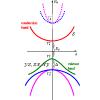当前位置:
X-MOL 学术
›
Phys. Rev. B
›
论文详情
Our official English website, www.x-mol.net, welcomes your feedback! (Note: you will need to create a separate account there.)
Magneto-Stark and Zeeman effect as origin of second harmonic generation of excitons inCu2O
Physical Review B ( IF 3.7 ) Pub Date : 2020-03-25 , DOI: 10.1103/physrevb.101.115201 A. Farenbruch , J. Mund , D. Fröhlich , D. R. Yakovlev , M. Bayer , M. A. Semina , M. M. Glazov
Physical Review B ( IF 3.7 ) Pub Date : 2020-03-25 , DOI: 10.1103/physrevb.101.115201 A. Farenbruch , J. Mund , D. Fröhlich , D. R. Yakovlev , M. Bayer , M. A. Semina , M. M. Glazov

|
We report on the experimental and theoretical investigation of magnetic-field-induced second harmonic generation (SHG) and two-photon absorption of excited exciton states () of the yellow series in the cuprous oxide . In this centrosymmetric material, SHG can occur due to constructive interplay of electric dipole and electric quadrupole/magnetic dipole transitions for light propagating along the low-symmetry directions [111] or [112]. By application of a magnetic field in Voigt configuration, SHG gets also allowed for excitation along the [110] axis and even the high-symmetry cubic direction [001]. Combining a symmetry analysis and a microscopic theory, we uncover the two key contributions to the magnetic-field-induced SHG: the Zeeman effect and the magneto-Stark effect. We demonstrate systematic dependencies of the SHG intensity on the linear polarization angles of the ingoing fundamental laser and the outgoing SHG beam, complementary to the paper by Rommel et al. [Phys. Rev. B 101, 115202 (2020)]. In general, the resulting contour plots in combination with a symmetry analysis allow one to determine uniquely the character of involved transitions. Moreover, we can separate in magnetic field the Zeeman and the magneto-Stark effect through appropriate choice of the experimental geometry and polarization configuration. We present a microscopic theory of the second harmonic generation of excitons in a centrosymmetric cubic semiconductor taking into account the symmetry and the band structure of cuprous oxide. Based on the developed microscopic theory, we identify the main contributions to the second-order nonlinear susceptibility of , and excitons. We analyze the redistribution of SHG intensities between the excitonic states both in the absence and presence of the magnetic field and show good agreement with the experimental data. With increasing exciton principal quantum number, the magneto-Stark effect overpowers the influence of the Zeeman effect.
中文翻译:

磁斯塔克和塞曼效应是Cu2O中激子二次谐波产生的根源
我们报告了磁场引起的二次谐波产生(SHG)和激发激子态的双光子吸收的实验和理论研究(氧化亚铜中的黄色系列 。在这种中心对称材料中,SHG可能是由于沿低对称方向[111]或[112]传播的光的电偶极子和电四极子/磁偶极子之间的建设性相互作用而发生的。通过在Voigt组态中施加磁场,SHG也可以沿[110]轴甚至是高对称立方方向[001]进行激励。结合对称性分析和微观理论,我们发现了磁场诱导的SHG的两个关键贡献:塞曼效应和磁斯塔克效应。我们证明了SHG强度对入射的基本激光和SHG光束的线性偏振角的系统依赖性,与Rommel等人的论文互补。[物理 B版 101,115202(2020)]。通常,结果轮廓图与对称分析相结合,可以唯一地确定所涉及过渡的特征。此外,我们可以在磁场中分离塞曼并通过实验几何形状和极化配置的适当选择磁斯塔克效应。考虑到氧化亚铜的对称性和能带结构,我们提出了中心对称立方半导体中激子二次谐波产生的微观理论。基于发达的微观理论,我们确定了对二阶非线性磁化率的主要贡献。和 激子。我们分析了在不存在和存在磁场的情况下,激子态之间SHG强度的重新分布,并与实验数据显示出良好的一致性。随着激子主量子数的增加,磁斯塔克效应克服了塞曼效应的影响。
更新日期:2020-03-26
中文翻译:

磁斯塔克和塞曼效应是Cu2O中激子二次谐波产生的根源
我们报告了磁场引起的二次谐波产生(SHG)和激发激子态的双光子吸收的实验和理论研究(氧化亚铜中的黄色系列 。在这种中心对称材料中,SHG可能是由于沿低对称方向[111]或[112]传播的光的电偶极子和电四极子/磁偶极子之间的建设性相互作用而发生的。通过在Voigt组态中施加磁场,SHG也可以沿[110]轴甚至是高对称立方方向[001]进行激励。结合对称性分析和微观理论,我们发现了磁场诱导的SHG的两个关键贡献:塞曼效应和磁斯塔克效应。我们证明了SHG强度对入射的基本激光和SHG光束的线性偏振角的系统依赖性,与Rommel等人的论文互补。[物理 B版 101,115202(2020)]。通常,结果轮廓图与对称分析相结合,可以唯一地确定所涉及过渡的特征。此外,我们可以在磁场中分离塞曼并通过实验几何形状和极化配置的适当选择磁斯塔克效应。考虑到氧化亚铜的对称性和能带结构,我们提出了中心对称立方半导体中激子二次谐波产生的微观理论。基于发达的微观理论,我们确定了对二阶非线性磁化率的主要贡献。和 激子。我们分析了在不存在和存在磁场的情况下,激子态之间SHG强度的重新分布,并与实验数据显示出良好的一致性。随着激子主量子数的增加,磁斯塔克效应克服了塞曼效应的影响。

























 京公网安备 11010802027423号
京公网安备 11010802027423号